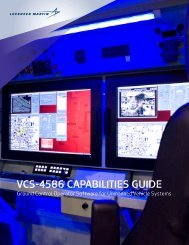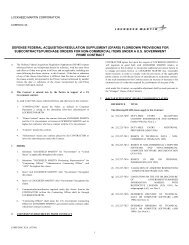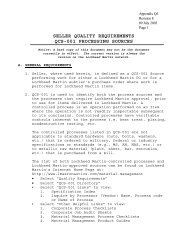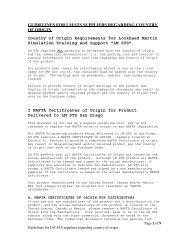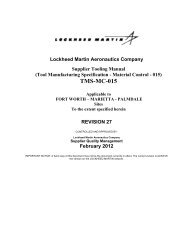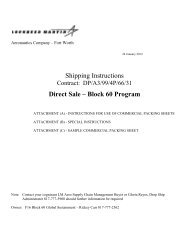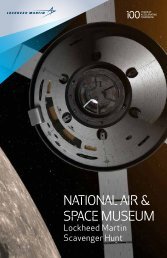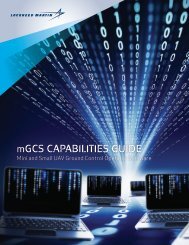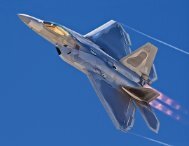Fleet Ballistic Missile Eastern Range Operations ... - Lockheed Martin
Fleet Ballistic Missile Eastern Range Operations ... - Lockheed Martin
Fleet Ballistic Missile Eastern Range Operations ... - Lockheed Martin
Create successful ePaper yourself
Turn your PDF publications into a flip-book with our unique Google optimized e-Paper software.
<strong>Lockheed</strong> <strong>Martin</strong><br />
Space Systems Company<br />
Test & Support Systems Engineering<br />
Pier Road, Hanger Y<br />
Mail Drop: MRL 156<br />
Cape Canaveral AFB, FL 32920<br />
321-476-7256<br />
eastern.range.fbm@lmco.com<br />
www.lockheedmartin.com<br />
K7036<br />
<strong>Fleet</strong> <strong>Ballistic</strong> <strong>Missile</strong> <strong>Eastern</strong> <strong>Range</strong> <strong>Operations</strong><br />
Supporting Navy Testing and Deployment
Partnering to Assure<br />
<strong>Fleet</strong> <strong>Ballistic</strong> <strong>Missile</strong> (FBM)<br />
Reliability and Credibility<br />
Cover: An unarmed Trident II D5 <strong>Fleet</strong> <strong>Ballistic</strong> <strong>Missile</strong><br />
emerges from the <strong>Eastern</strong> <strong>Range</strong>’s Atlantic waters in a Navy test<br />
of reliability. With a nominal range of 4,000 nautical miles, the<br />
powerful missile features three-stage, solid-fuel propulsion,<br />
inertial guidance and multiple independently targeted reentry<br />
vehicles. Trident II-configured Ohio-class submarines carry the<br />
D5 missiles, which were first deployed in 1990.<br />
Photo courtesy of NASA<br />
How does the Navy<br />
assure the reliability and credibility<br />
of its submarine-based<br />
<strong>Fleet</strong> <strong>Ballistic</strong> <strong>Missile</strong>s (FBMs)?<br />
One important way is through<br />
test launches of the missiles in<br />
the Atlantic Ocean on the Air<br />
Force <strong>Eastern</strong> <strong>Range</strong> and in the<br />
Pacific utilizing range assets<br />
managed by the Naval Air<br />
Systems Command, Point<br />
Mugu, California.<br />
For the vast test and<br />
space launch arena known as<br />
the <strong>Eastern</strong> <strong>Range</strong>, the Cape<br />
Canaveral area in Florida serves<br />
as the point of departure.<br />
Submarines and surface ships<br />
leave Port Canaveral to make<br />
way to deep-sea test locations in<br />
the range’s 10,000-mile stretch of<br />
ocean. From land-based launch<br />
pads at Cape Canaveral Air<br />
Force Station and Kennedy<br />
Space Center, rockets propel<br />
satellites, spacecraft and other<br />
payloads through the range’s<br />
15 million square miles of instrumented<br />
airspace.<br />
In the maritime provinces<br />
of the range, the U.S. Navy conducts<br />
FBM tests from Trident IIconfigured<br />
Ohio-class submarines.<br />
The test launches of these vital<br />
strategic deterrents provide reliability<br />
and accuracy performance<br />
information to the Joint Chiefs<br />
of Staff and the U.S. Strategic<br />
Command, as part of ongoing<br />
operational system evaluation.<br />
For each test, missiles are randomly<br />
selected and converted to<br />
an unarmed test configuration,<br />
and then launched from deployed<br />
submarines under operationally<br />
representative conditions.<br />
Who partners with U.S.<br />
Navy Strategic Systems Programs<br />
personnel to support these tests<br />
and other FBM operations at<br />
the <strong>Eastern</strong> <strong>Range</strong>? The skilled<br />
men and women of <strong>Lockheed</strong><br />
<strong>Martin</strong> Space Systems Company,<br />
the Navy’s prime FBM strategic<br />
missile system contractor and<br />
missile system program manager<br />
for more than 50 years.<br />
The D5 missile’s superb record is a result of continual technical advances<br />
under the exceptional leadership of the Navy’s Strategic Systems Programs.<br />
The Navy’s rigorous testing program helps to ensure the reliability<br />
and credibility of this critical national security asset.<br />
1
2<br />
Providing Customer Support<br />
with FBM Depth and Breadth<br />
When the Navy tested the first FBM, the Polaris A1, at the<br />
<strong>Eastern</strong> <strong>Range</strong> in the 1950s, <strong>Lockheed</strong> <strong>Martin</strong> was there. That close<br />
partnership has continued through the testing of every generation of<br />
FBM since then, including today’s Trident II D5. With the Trident II<br />
D5, the Navy has achieved a record of reliability unmatched by any<br />
other large ballistic missile – well over a hundred consecutive<br />
successful test launches since 1989 in the<br />
Atlantic and Pacific oceans.<br />
<strong>Lockheed</strong> <strong>Martin</strong> personnel<br />
contribute technical and operational depth and<br />
breadth in support of the Naval Ordnance Test Unit, the organization<br />
within Navy Strategic Systems Programs that directs FBM<br />
operations at the <strong>Eastern</strong> <strong>Range</strong>.<br />
Dedicated to meeting the Navy’s goals and requirements,<br />
more than 400 <strong>Lockheed</strong> <strong>Martin</strong> employees work on the FBM program<br />
in more than 20 buildings at Cape Canaveral Air Force<br />
Station. Two of these buildings—one for engineering and analysis<br />
and the other for missile research—make up the company’s newest<br />
<strong>Eastern</strong> <strong>Range</strong> facility, the FBM Post-Production Center of<br />
Excellence that opened in 2006.<br />
<strong>Lockheed</strong> <strong>Martin</strong> talent includes engineers, technicians and<br />
other specialists who aid the Navy in assembling, installing, testing<br />
and repairing the missiles. Combining veteran employees with years<br />
of experience and recent college graduates with fresh perspectives<br />
forms a strong and effective team.<br />
The full team of more than 2,600 <strong>Lockheed</strong> <strong>Martin</strong> FBM<br />
employees is devoted to the Navy’s needs in six states—Florida,<br />
California, Georgia, Washington, Utah and Virginia. Their work<br />
encompasses every aspect of the Trident II D5 strategic<br />
weapon system, from design to development to production to<br />
testing to operation. Their guiding philosophy remains “We never<br />
forget who we’re working for ® .”<br />
The close partnership between the Navy and<br />
<strong>Lockheed</strong> <strong>Martin</strong> has continued through every<br />
FBM generation—from the 1950s’ Polaris A1<br />
to today’s Trident II D5.<br />
A technician tests a new handling tool designed by<br />
<strong>Eastern</strong> <strong>Range</strong> support equipment engineers to automate<br />
installation of the D5 nose cap snubber during missile<br />
assembly at the Strategic Weapons Facility, Atlantic<br />
(SWFLANT).<br />
Naval Ordnance Test Unit:<br />
Directing FBM <strong>Eastern</strong><br />
<strong>Range</strong> <strong>Operations</strong><br />
The Naval Ordnance Test Unit, a<br />
major field activity of U.S. Navy Strategic<br />
Systems Programs, directs all FBM operations<br />
at the <strong>Eastern</strong> <strong>Range</strong>.<br />
This unit oversees and performs test,<br />
launch and evaluation of the missile system<br />
during development. The unit plays an integral<br />
role in supporting FBM demonstration<br />
and shakedown operations, commander<br />
evaluation tests and follow-on commander<br />
evaluation tests of the system. And, for flight<br />
test vehicles, the unit supports tracking,<br />
telemetry and range safety equipment.<br />
The many “firsts” the Naval<br />
Ordnance Test Unit has supported include<br />
the first Polaris missile launch from a surface<br />
ship off the coast of Florida in 1959 and<br />
the first from a submarine in 1960. The unit<br />
later supported the Poseidon C3, Trident I<br />
C4 and Trident II D5 development and<br />
operational evaluation test flight programs.<br />
Since the 1950s, the unit has had a<br />
presence at Cape Canaveral Air Force<br />
Station. Headquarters for the Naval<br />
Ordnance Test Unit were officially relocated<br />
to Cape Canaveral Air Force Station in 1977.<br />
3
4<br />
Delivering a Full <strong>Range</strong> of FBM Expertise and Service<br />
In the course of supporting<br />
the Navy in assembly, installation,<br />
testing, repair and operation of the<br />
missiles, <strong>Lockheed</strong> <strong>Martin</strong> provides<br />
an array of specialized services at<br />
the <strong>Eastern</strong> <strong>Range</strong>. These services<br />
include the following:<br />
Development and Operational<br />
Evaluation Tests. <strong>Lockheed</strong><br />
<strong>Martin</strong> <strong>Eastern</strong> <strong>Range</strong> personnel<br />
support in-tube conversions of<br />
FBMs—from tactical to test configuration<br />
at Naval Submarine<br />
Base Kings Bay—for performance<br />
Photo courtesy of NASA<br />
D5 experimental vehicle one<br />
(D5X-1) lifts off from the launch<br />
pad at Complex 46A at Cape<br />
Canaveral, Florida, in 1987. The<br />
vehicle flew down the <strong>Eastern</strong><br />
<strong>Range</strong> to an impact area in the<br />
south Atlantic Ocean, fulfilling a<br />
commitment made to the nation<br />
when the Secretary of Defense<br />
approved the Trident II D5<br />
development program in 1981.<br />
evaluation missile tests, demonstration<br />
and shakedown operations,<br />
commander evaluation tests and<br />
follow-on commander evaluation<br />
tests conducted from FBM submarines<br />
(SSBNs). <strong>Lockheed</strong><br />
<strong>Martin</strong> personnel also provide<br />
industrial and administrative support<br />
to visiting submarine crews.<br />
Test <strong>Missile</strong> Instrumentation Kit<br />
Production. Trident II D5 test<br />
missile kits convert operational<br />
missiles to a test configuration<br />
and provide range safety controls<br />
plus telemetry instrumentation.<br />
Kit processing takes place in a<br />
specially designed facility within<br />
the <strong>Missile</strong> Assembly and Checkout<br />
Area.<br />
Surface Support Equipment<br />
Design, Production and<br />
Proofing. The Support Equipment<br />
Area in Complex 30 and the<br />
<strong>Missile</strong> Assembly and Checkout<br />
Area, located in the Mechanical<br />
Equipment Support Systems Area,<br />
<strong>Lockheed</strong> <strong>Martin</strong><br />
provides an array of<br />
specialized services to<br />
support the Navy’s needs<br />
at the <strong>Eastern</strong> <strong>Range</strong>.<br />
proof new designs and design<br />
alterations for electrical and<br />
mechanical support equipment.<br />
They also provide problem identification<br />
and solution analysis.<br />
Deployed System Support. FBM<br />
deployed system activities include<br />
program management; logistics,<br />
facility and field engineering;<br />
information technology; finance<br />
and business operations; technical<br />
publications and information<br />
systems.<br />
Logistics Support. Functions at<br />
Port Canaveral include the Data<br />
Acquisition and Reduction Center,<br />
which provides reduction of flight<br />
and ground test data; a test<br />
equipment laboratory; a type III<br />
certified calibration laboratory;<br />
and administration services<br />
(stockrooms, reproduction, mail<br />
and fleet transportation, finance,<br />
payroll, human resources, security,<br />
and environmental, safety<br />
and hazardous engineering).<br />
Test reentry bodies streak toward<br />
their targets in the Atlantic Ocean<br />
near Ascension Island at the far<br />
end of the <strong>Eastern</strong> <strong>Range</strong>.<br />
Shop Services. <strong>Lockheed</strong> <strong>Martin</strong>’s<br />
machine shop and electrical labs<br />
feature a quick prototype capability<br />
to simulate almost any activity<br />
that occurs in the field or fleet.<br />
They build prototype hardware<br />
and one-of-a kind items, perform<br />
electrical failure detection and<br />
analysis, and support rework of<br />
surface support equipment. They<br />
also investigate and resolve field<br />
and fleet-related support equipment<br />
anomalies, and support missile and<br />
missile component problem<br />
investigations.<br />
Documentation Development.<br />
Technical experts review change<br />
documents, update instructions<br />
for missile processing and support<br />
equipment maintenance, and<br />
support design change implementation,<br />
hardware proofing,<br />
modification kit assembly and<br />
documentation release.<br />
FBM <strong>Eastern</strong> <strong>Range</strong> personnel install<br />
a new air conditioner on the Trident<br />
II D5 Service Unit. The Service Unit,<br />
a movable structure, is used at<br />
Strategic Weapons Facilities during<br />
conversion of a tactical missile to a<br />
test missile.<br />
5
6<br />
<strong>Fleet</strong> Support. The Mechanical<br />
Equipment Support Systems Area<br />
complex maintains space and<br />
equipment for evaluating, testing<br />
and demonstrating equipment for<br />
all program phases. These include<br />
proofing of proposed weapon systems<br />
alterations, slow-run-through<br />
evaluations and personnel familiarization<br />
for reentry and missile<br />
body/in-tube conversion operations.<br />
Failure Analysis. Post-Production<br />
Center of Excellence personnel<br />
submit Navy fleet-returned items<br />
to labs located on the National<br />
Aeronautics and Space Administration<br />
complex for failure<br />
analysis and determination of root<br />
cause for metallic and non-metallic<br />
objects.<br />
Administration. <strong>Lockheed</strong><br />
<strong>Martin</strong> develops and administers<br />
systems and procedures for personnel<br />
and property security,<br />
property accountability, control<br />
of expenditures, procurement of<br />
supplies and materials, property<br />
and equipment maintenance and<br />
documentation. <strong>Lockheed</strong> <strong>Martin</strong><br />
also provides maintenance and<br />
repair of government property<br />
and materiel services for FBM<br />
associate contractors.<br />
<strong>Eastern</strong> <strong>Range</strong> technicians evaluate<br />
a new thermal relief valve design on<br />
an active inert missile in the<br />
Mechanical Equipment Support<br />
Systems Area in the <strong>Missile</strong> Assembly<br />
and Checkout Area.<br />
The 45th Space Wing:<br />
Operating the<br />
<strong>Eastern</strong> <strong>Range</strong> as<br />
a National Asset<br />
The 45th Space Wing of<br />
the U.S. Air Force Space<br />
Command operates and maintains<br />
the <strong>Eastern</strong> <strong>Range</strong>, a<br />
national asset used by numerous<br />
military and government agencies.<br />
With headquarters at<br />
Patrick Air Force Base, Florida,<br />
the wing supports military, civil<br />
and commercial space launch<br />
missions, as well as submarinelaunched<br />
ballistic missile tests<br />
and evaluations.<br />
The wing and its contractors<br />
work with the many<br />
organizations involved in launch<br />
and range operations. These<br />
include the U.S. Navy, National<br />
Aeronautics and Space<br />
Administration, National<br />
Reconnaissance Office and the<br />
Air Force Space and <strong>Missile</strong><br />
Systems Center.<br />
The lineage of today’s<br />
45th Space Wing dates to the<br />
Air Force Division of the Joint<br />
Long <strong>Range</strong> Proving Ground,<br />
an Air Force-Army-Navy<br />
organization established in<br />
1949 to manage missile testing<br />
and launch operations on the<br />
range. By l956, nine tracking sites<br />
and the first 1,000 miles of the<br />
<strong>Eastern</strong> <strong>Range</strong> were in operation.<br />
By 1963, the range had stretched<br />
10,000 miles from the Florida<br />
mainland through the South<br />
Atlantic and around the<br />
Southern tip of Africa to the<br />
Indian Ocean.<br />
<strong>Lockheed</strong> <strong>Martin</strong> <strong>Eastern</strong> <strong>Range</strong> workers install the<br />
S-band Mobile Array Telemetry (SMART) antenna system<br />
on board the USS Pathfinder, an FBM test range support<br />
ship, at Port Canaveral.<br />
7
Dedicated to meeting Navy mission requirements, <strong>Lockheed</strong> <strong>Martin</strong><br />
employees working at the <strong>Eastern</strong> <strong>Range</strong> provide Trident II D5 FBM deployed<br />
systems support, including program management, logistics, facility and field<br />
engineering, and business support functions.




